Alltech recently conducted a harvest analysis survey for corn silage and various grains to identify which mycotoxins are present and their levels of concentration in this year’s crops.
The analysis was utilized to identify which of a possible 38 mycotoxins were present in each sample.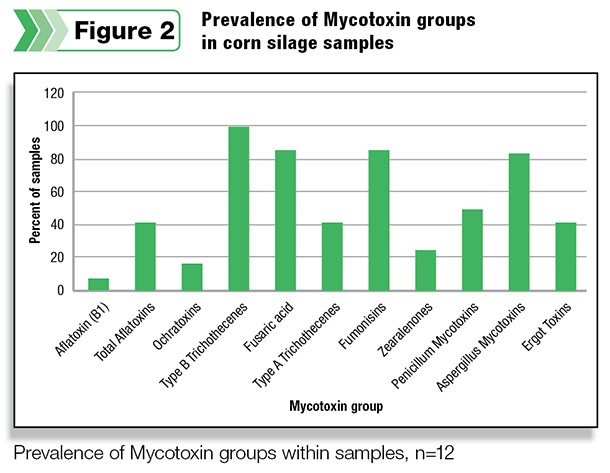
In corn silage samples, 92 percent contained six to 11 mycotoxins (Figure 2). Type B Trichothecenes was found in 100 percent of the samples.
These toxins can pose a risk to the herd’s dry matter intake (DMI), milk production, gut health and immune response. Fusaric acid was present in more than 80 percent of all samples as well as fumonisins and other aspergillis toxins.
Fusaric acid can act synergistically to magnify the effects of Type B Trichothecenes. Fumonisins and other aspergillis can impact gut health through digestive disorders, cause liver damage and lower immune response.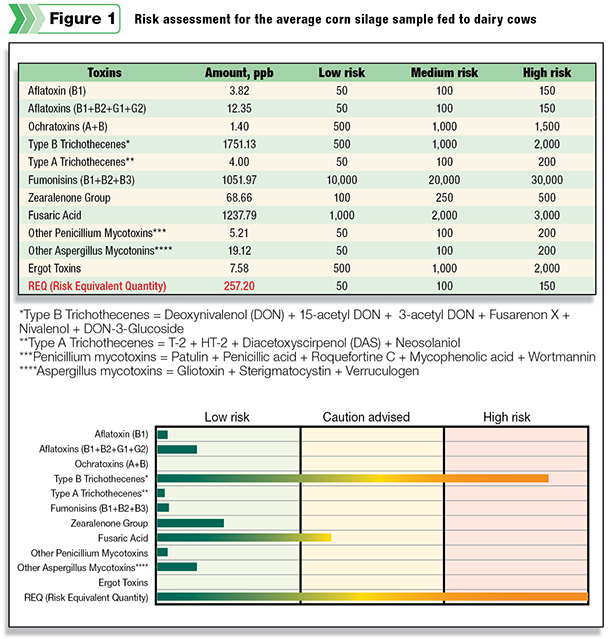
Considering this information, along with the sensitivity of the dairy cow to those mycotoxins, allows the provision of an overall risk assessment (Figure 1) which considers the total impact that the group of mycotoxins present in samples analyzed is likely to have on the animal. The REQ for the average corn silage sample was 257, and high risk for dairy cows was 150.
The inclusion rate of the corn silage will determine the mycotoxin contribution to the TMR, but at normal inclusion rates, the REQ would be from caution to high risk.
Type B Trichothecenes is the main group of toxins of concern and can be magnified in the presence of fusaric acid. This approach reflects the reality facing producers. It is not enough to measure each individual toxin because the cumulative effect of the group is often far greater than that of each individual toxin.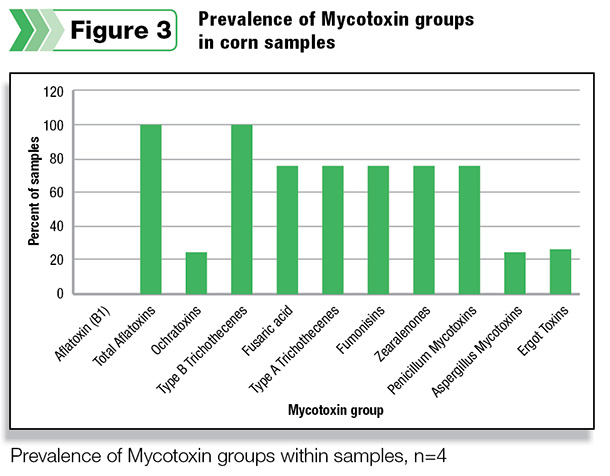
All corn samples (Figure 3) contained Type B Trichothecenes and total aflatoxins. As was stated previously, Type B Trichothecenes can impact DMI, milk production, gut health and immune response.
Total aflatoxins can impact fibre digestion, DMI, milk and immune response. Together, these toxins pose a threat to cow health and performance.
Penicillium toxins were present in 78 percent of the samples, and these toxins can lower rumen function by altering rumen flora and volatile fatty acid (VFA) concentrations.
They can increase rapidly in storage and require monitoring. The inclusion rate of the corn will determine the mycotoxin contribution to the TMR. Although this is usually low in comparison to forage inclusion, mycotoxins are still being brought to the TMR.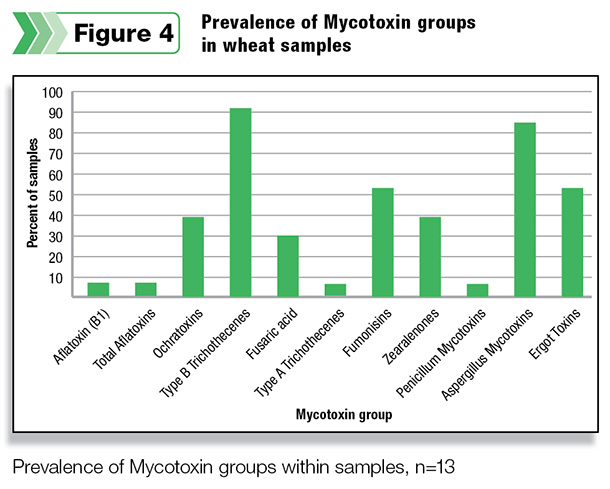
Seventy-five percent of the wheat samples were contaminated with more than nine mycotoxins, 90 percent of wheat samples had Type B Trichothecenes, and 80 percent had aspergillis toxins (Figure 4).
The presence of these two mycotoxin groups brings a risk to cow gut health and immune response.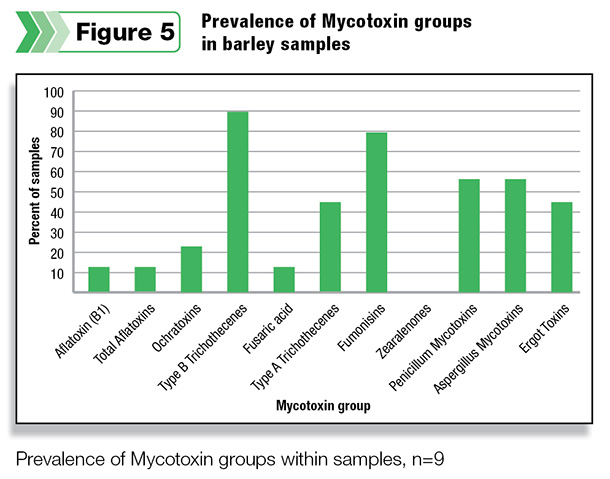
In barley (Figure 5), Type B Trichothecenes were the most prevalent group at 89 percent of samples contaminated, followed by fumonisins in 78 percent of samples.
Aflatoxin B1 was identified in 10 percent of the samples, and this should be kept in consideration as barley is used. This mycotoxin can increase in stored grains if proper storage management is not maintained.
The Canadian harvest analysis has identified that mycotoxins are present, and the majority of all samples contain multiple mycotoxins.
To address this challenge, a thorough mycotoxin management program needs to be employed. This would involve utilizing a risk assessment and an on-farm program to better manage forages and stored feedstuffs.
Most mycotoxin problems go undiagnosed due to lack of perseverance or a lack of records and analysis that may be used for diagnostic purposes.
The management team at the dairy must be willing to cooperate with each other. One of the most important factors is good record-keeping at the dairy. Documentation of production, breeding and treatment records are extremely valuable in this situation.
Feed and ingredient analysis records are of the utmost importance in determination of the cause and source of a case of mycotoxicosis.
It is not uncommon to take immediate measures at the dairy before the diagnostic process is completed.
In many cases, the need for immediate results is necessary in an effort to help try to resume normal production, reproduction and health status of the affected herd.
In some instances, the actions taken at this point are the determining factor in diagnosing whether or not mycotoxins were a problem in the first place.
Some of the most common practices employed are to eliminate the suspected source of the mycotoxin (e.g., silage, haylage, whole cottonseed, almond hulls, etc.) to include a mold-inhibition product (e.g., use of fungicides or mold inhibitors on the TMR or corn silage), or to use a mycotoxin sequestering agent in the ration. PD
Max Hawkins holds a Ph.D. in animal science from the University of Tennessee and currently serves as a nutritionist on the Alltech Mycotoxin Management Team.

- Max Hawkins
- Nutritionist
- Alltech









